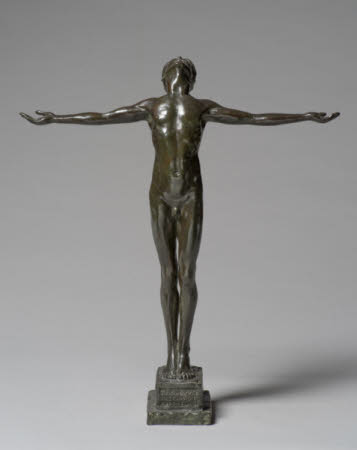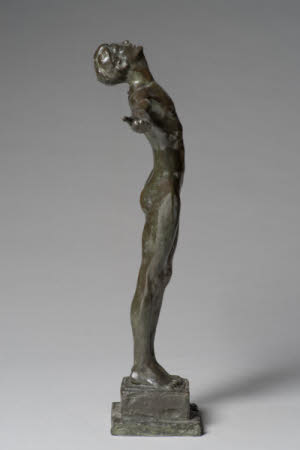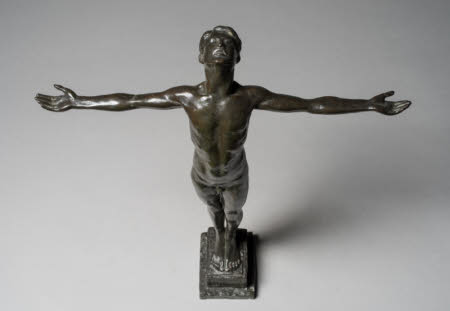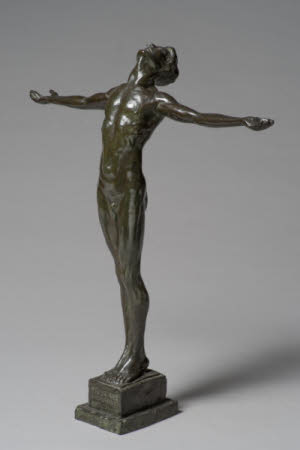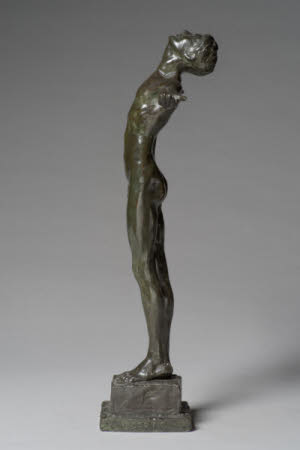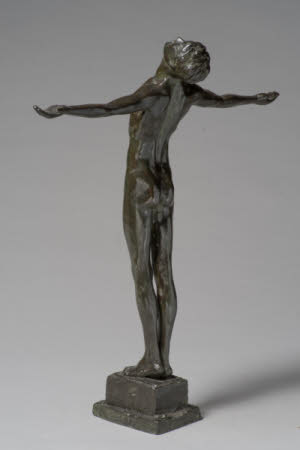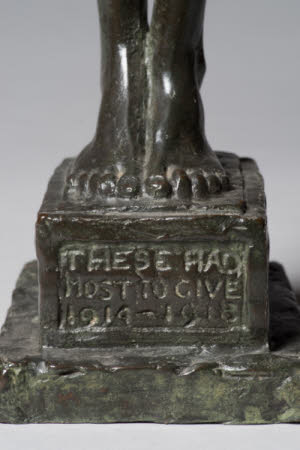'These had most to give'
Kathleen Scott (Carlton in Lindrick 1878 - London 1947)
Category
Art / Sculpture
Date
1922 - 1923
Materials
Bronze
Measurements
454 x 398 mm
Place of origin
London
Order this imageCollection
Anglesey Abbey, Cambridgeshire
NT 515080
Caption
In 1934 Kathleen Scott was described as ‘one of the greatest woman sculptors of her time’. Three years later, as part of its ‘World of Women’ series, the BBC dedicated its first-ever television programme on sculpture to her. The creator of 220 recorded works, Scott was as prolific as she was prominent – famed and framed, if not typecast, as the stoic widow of the Antarctic explorer Robert Falcon Scott (1868–1912). Born Kathleen Bruce, she trained at the Slade School of Art (1900–2) before moving to Paris. Her diaries recount six exciting years in the city. She lived with the designer Eileen Gray and knew Auguste Rodin. Back in London, Scott’s sculpted portraits of friends in the public eye built her name and reputation. Periodically, Scott paused sculpture in favour of humanitarian work. She went to Macedonia on a child-relief mission and during the First World War assisted the ambulance service and made electric coils for a machine-gun factory. In the aftermath of war, she was a modeller for a pioneering facial reconstruction and plastic-surgery unit. ‘These men without noses are very beautiful’, she observed in her diary, ‘like antique marbles’. These had most to give was one of her best works. Conceived as a war memorial – the ‘outstretched hands and the upturned head’ were, she said, ‘expressive of sacrifice’ and the war’s ‘holocaust of youth’. The final, large-scale statue was erected in a new context, as a monument to those killed on the British Antarctic Expedition of 1911–12 (Scott Polar Research Institute, Cambridge). Kathleen Scott did not readily accept the label ‘woman sculptor’ – ‘I don’t believe in them’, she once wrote. Reflecting on what it meant to be a sculptor (of any gender), she counselled: ‘There is much climbing about on ladders and scaffolds, with heavy weights to lift and mallets to swing.’ But for the willing, the reward is ‘the most grateful, generous, and abundant of professions’.
Summary
Bronze, 'These had the most to give', Kathleen Scott (Edith Agnes Kathleen Young, Lady Kennet, 1878-1947), 1922-1923. A bronze model for the large bronze statue by Kathleen Scott, now in the forecourt of the Scott Polar Research Institute in Cambridge, where it serves as a memorial to the British Antarctic Expedition of 1911-12, on which several members of the party perished, among them the sculptor’s first husband, Robert Falcon Scott. The sculpture was originally intended as a First World War memorial, a purpose specifically referred to in the inscription on the smaller Anglesey Abbey version.
Full description
Kathleen Scott, as she was when she made this sculpture, was born Edith Agnes Kathleen Bruce, the youngest daughter in the large family of an Anglican clergyman. She was orphaned at an early age which may have helped foster the spirit of fierce independence that characterised her personality and her professional career as a sculptor. The young Kathleen Bruce trained at the Slade School in London between 1900 and 1902. During this period she had the chance to see major works by Auguste Rodin, the Burghers of Calais and the Saint John the Baptist, which helped determine her to enrol in the Académie Colarossi in Paris, where she was to live between 1902 and 1906, meeting Rodin, who admired her work, and exhibiting on several occasions. On her return to London, Kathleen Bruce continued to practise as a sculptor, but also enjoyed social life. With a striking gift for friendship, she was on close terms with many of the most prominent artists, writers and politicians of the day. In 1908 she married the polar explorer Robert Falcon Scott, who was to perish in 1912, in the disastrous end to his ill-fated second Antarctic Expedition. The bronze memorial statue of 1915 to Captain Scott, on Waterloo Place, London, is today Kathleen Scott’s best-known work. She was subsequently to marry, in 1922, Edward Hilton Young, who was knighted in 1927 and created Baron Kennet in 1935. During the First World War, Kathleen Scott continued to work on sculptures, including the bronze figure of Scott and its marble replica in Christchurch, New Zealand, but she was formidably active in other ways, establishing an ambulance service in France, working in a Vickers factory and also modelling faces as part of the pioneering work of reconstruction through plastic surgery of faces disfigured on the battle fields. During the years between the wars, Kathleen Scott would become one of the most popular and successful British sculptors, exhibiting frequently at the Royal Academy and elsewhere, including several solo exhibitions. In 1937 she was the subject of the BBC’s first ever television programme on sculpture, whilst in 1938 was published Homage, a luxurious book on her sculpture with commentary by Stephen Gwynn. Scott’s work falls into two main categories, portrait busts and idealised statues, which almost exclusively take young men as their subject. Kathleen Scott, who idolised her two sons, the naturalist Sir Peter Scott and, from her second marriage Wayland Hilton Young, evidently felt a special empathy with young boys and men, once commenting that ‘really the only thing I’ve cared about are young male objects’ (James Lees-Milne, Fourteen Friends, London 1996, p. 10). Her portraits of contemporaries are still admired as often sensitive and truthful portrayals of character, but her idealised figures of young male nudes have generally fallen out of favour and become less highly regarded. Kathleen’s close friend James Lees-Milne felt that her figurative work lacked real genius: ‘Kathleen’s allegorical compositions, her Laus Deo, The Kingdom is Within, These had most to Give, Progress and so on, are mostly represented by naked figures of very young men, with outstretched arms. Their exclamatory gestures and strivings towards the sublime are fairly commonplace, sometimes verging on that sentimentality which Kathleen deplored in others.’ (Lees-Milne, Fourteen Friends, pp. 15-16). Nevertheless, for her often superb portrait busts and with her ideal sculptures being seen today with a more measured perspective, Kathleen Scott is now seen as ‘surely the most significant British woman sculptor of this century before Barbara Hepworth.’ (Mark Stocker, ‘”My Masculine Models”: The sculpture of Kathleen Scott’, Apollo, CL (September 1999), pp. 47-54, p. 54). These had most to give, Kathleen Scott’s most important ideal sculpture, was her own favourite work (Stocker, ”My Masculine Models”, p. 50). The sculpture was conceived as a memorial to the fallen in the First World War. The sculptor herself was the cause of some confusion over when the sculpture was actually modelled, claiming in 1938 that the life-size bronze had been made in the spring of 1919, just a few months after the ending of the War (K. Scott (Lady Kennet), Homage. A Book of Sculptures, commentary by Stephen Gwynn, London 1938, XXXIX). However, her diaries record that she in fact created the sculpture in December 1922, using for a model the then 22 year-old Arnold Lawrence (1990-91), youngest brother of T.E. Lawrence (Lady Kennet (Kathleen, Lady Scott), Self-Portrait of an Artist, London 1949, p. 215; Alison Jolley, ‘Let Light Perpetual Shine’, The T.E. Lawrence Society Newsletter, No. 97 (2011), pp. 11-13). Arnold Lawrence would later become Professor of Classical Archaeology at the University of Cambridge, so would have continued to encounter the sculpture over many decades, until his death in 1991. During the sittings, the young Lawrence poured out his anxieties to Scott, who recorded in her diary that he was ‘rather frightened of himself – told me he has told more about himself than he ever had to any other one. Poor boys, I love them at that age, they are so certain they are the only individuals who have ever lived and had emotions…’ (Stocker, “These had most to give”, p. 52). The sculpture is fluently and naturalistically modelled, with a yearning quality. Scott commented that the ‘outstretched hands and the upturned head are expressive of sacrifice, of absolute surrender to ideas, and I intended it to typify the holocaust of youth during the war.’ (Eastern Daily Express, 28 March 1927, cited in Stocker, “These had most to give”, pp. 52-53). The commentary on the large version by Stephen Gwynn in Homage, written with Lady Kennet’s guidance and approval, and in 1938, as the storm clouds gathered once again over Europe, also very clearly states the original intention of “These had most to give” as a war memorial: ‘A war memorial of the young. Offering the whole of life in one wide gesture of devotion to some unseen object from above, the figure shoots up from the ground like a growing plant; and its very slenderness seems to invite the scythe. It is a terrible symbol; and the perfect modelling of that young body, taut like a bow in readiness for all life’s uses, alive to the very toes with palpitating flesh, sums up in one image all that over all Europe of its own motion, obeying its own impulse to give, was reaped and gathered into the common charnel-house.’ The large-scale bronze cast was exhibited several times in the years after it was made, at the Royal Academy in the 1923 Summer Exhibition (no. 1512, entitled ‘Offering’ and with the subtitle ‘1914-1918. These had most to give’), at the Grosvenor Galleries, the British Empire Exhibition of 1924 at Wembley, and the 1925 Salon in Paris, at which it was awarded a bronze medal. However, despite this wide exposure, it was not selected for a war memorial, some commentators suggesting that despite the beauty of the composition, the sculpture lacked focus. So it remained unsold, Lady Kennet keeping it for several years in her London garden. These had most to give was once again exhibited in October 1934 at the solo exhibition of her works held at the Fine Art Society (no. 13, ‘These had most to give (bronze)’), along with, at no. 27, the small sketch model. Lord Fairhaven almost certainly would have bought his bronze on the occasion of the exhibition. Kathleen Kennet was heavily involved in the plans for the building of the Scott Polar Research Institute in Cambridge and seems as early as 1932 to have offered the large version of These had most to give to stand outside the new building. After much debate and a fair degree of opposition, which has been documented in detail by Mark Stocker (“These had most to give”, pp. 53-56), the sculpture was, following the Fine Art Society exhibition, sent to Cambridge as a gift, to be unveiled with the opening of the new building on 20 November 1934. After decades of often condescending neglect, it is now increasingly recognised as an important work both within Kathleen Scott’s career and more broadly within the context of modern British sculpture. For its unveiling, the version at the Scott Polar Research Institute was given a new inscription, ‘Lux perpetua luceat eis’ (‘May everlasting light shine on them’) which, together with the sculpture’s new context as a memorial to Captain Scott and his fellow members of the 1911-12 Antarctic expedition, largely subverts the original purpose of the sculpture as a war memorial. The sketch at Anglesey Abbey, which retains its inscription specifically referring to the fallen of the 1914-1918 War, therefore remains the key for understanding the original conception of These had most to give. Jeremy Warren 2019
Provenance
Probably acquired by Urban Huttleston Rogers Broughton, 1st Lord Fairhaven (1896-1966) in October 1934 at the Fine Art Society exhibition, Sculpture by Lady Hilton Young (K. Scott), no. 27, ‘Sketch for No. 13 (bronze)’; identifiable in the Anglesey Abbey inventory 1940, p. 33, Newmarket Room, valued at £18; bequeathed to the National Trust by Lord Fairhaven with the house and the rest of the contents.
Credit line
Anglesey Abbey, The Fairhaven Collection (The National Trust)
Marks and inscriptions
On front of base: THESE HAD / MOST TO GIVE / 1914-1918 On right side of base : K SCOTT On right side of base, above artist's signature : SC[...]
Makers and roles
Kathleen Scott (Carlton in Lindrick 1878 - London 1947), sculptor
References
Catalogue of Sculpture by Lady Hilton Young (K. Scott), exh. cat., venue: Fine Art Society, London, October 1934, no. 27. 'Anglesey Abbey, Lode, Cambridgeshire. An Inventory and Valuation of Furniture, Books, Ornamental Items & Household Effects .. prepared for Insurance Purposes’, Turner, Lord and Ransom, April 1940, p. 33. Christie, Manson & Woods 1971: The National Trust, Anglesey Abbey, Cambridge. Inventory: Furniture, Textiles, Porcelain, Bronzes, Sculpture and Garden Ornaments’, 1971, p. 136. Stocker 2015: Mark Stocker, ‘”These had most to give”: Kathleen Scott’s sculpture at the Scott Polar Research Institute, Cambridge’, Polar Record, 51 (2015), pp. 49-57., p. 54. Conroy, Rachel, Women Artists and Designers at the National Trust, 2025, pp. 174-5
